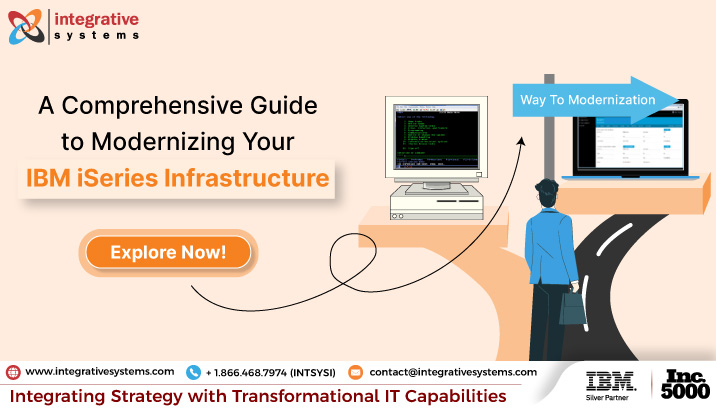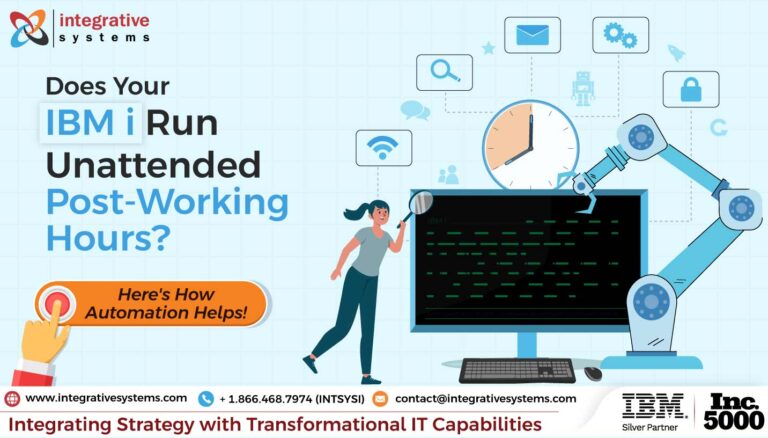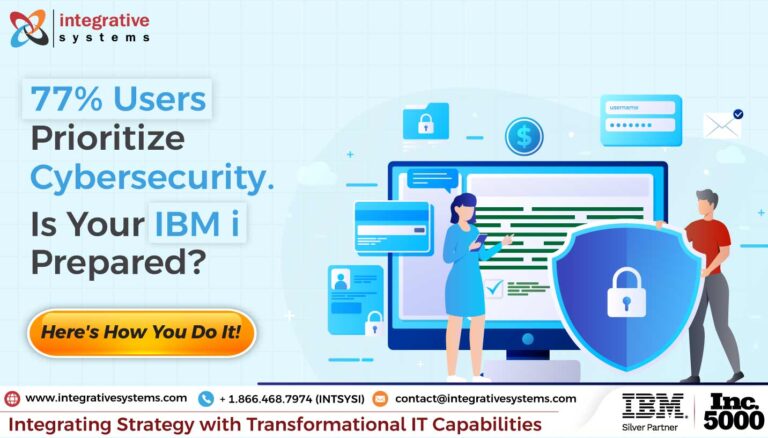Do you find it hard to upgrade, integrate, and customize your IBM iSeries ecosystem?
Is it becoming difficult for your company to make the most out of IBM iSeries infrastructure and ecosystem?
Well, you are not alone.
Many companies across the globe find it difficult to manage and make the most out of the IBM iSeries environment to achieve their business goals.
But if you want to overcome this issue and extract all the benefits from as400 iSeries this guide is all you need.
Agreed it’s bit lengthy but trust us it has everything you need!
You’ll get everything in it like –
- History of IBM i
- Tools & technologies
- Changes in the AS400 analogies
- Top system utilities offered by IBM i
- What IBM i holds in the future for you
- Trends to watch for as an IBM I user
- Cloud migration, IBM i application modernization…
And much more!
Without any further ado, let’s begin with the first chapter of history!
History of IBM i (AS400)
Having a look at the history of IBM i will help you get your foundation strong. During the past few decades, IBM has changed the name and codes of its servers and operating system quite a few times.
Have a look at the below table:
| Year | Server Name | OS Name |
| 1978 | System/38 | CPF |
| 1983 | System/36 | System/36 |
| 1988 | AS400 | OS400 |
| 2000 | iSeries | OS400 |
| 2006 | System i | i5/OS |
| 2008 | IBM Power System | IBM i |
Now you also need to upgrade to the latest IBM operating system and servers to create your fully-fledged IBM iSeries ecosystem.
A Look Back at the History of the IBM i
The journey of the IBM i is an exciting tale of evolution and innovation, marking significant leaps in information technology.
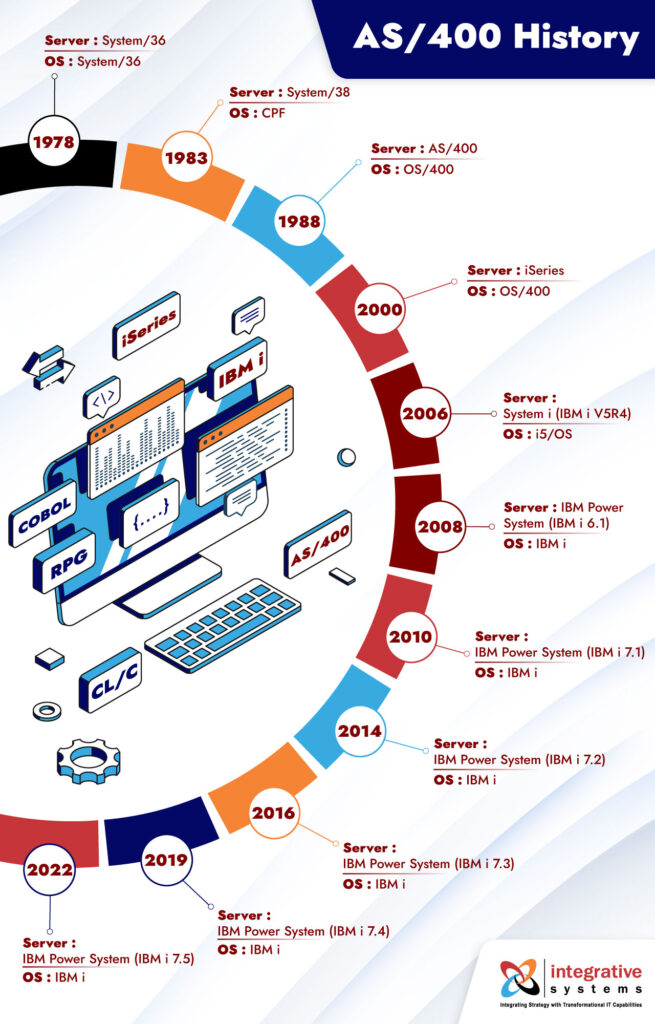
1978
IBM took its first step into integrated systems with the launch of the System/38. This system heralded the dawn of the technology we now know as the IBM i. The System/38 ran on the Control Program Facility (CPF) operating system, a groundbreaking development pioneering single-level storage and object-oriented programming.
1983
IBM introduced the System/36. The System/36 was more affordable and easier to use than its predecessor, making it a hit among small to medium-sized businesses. It introduced us to the System/36 operating system, which later played a crucial role in developing the IBM i.
1988
The introduction of the AS400 system, running on the OS400 operating system, revolutionized the IT landscape. The AS400, known for its integrated database and backward compatibility, quickly became the preferred choice for businesses worldwide.
2000
The AS400 was rebranded as the iSeries, but the underlying technology remained largely the same; the name change represented a shift towards a more integrated and internet-focused platform.
2006
A new name emerged, System I. The System I was designed to run traditional iSeries and Java, Linux, and Windows applications. It was accompanied by an updated operating system, the i5/OS, reflecting advancements in hardware and software capabilities.
2008
IBM unveiled the IBM Power System running on the IBM i operating system. This departed from the earlier nomenclature and represented a significant step towards embracing future technological trends.
Having journeyed through the history of the IBM i, let’s now shift gears and delve into the details of rudimentary tools in IBM i.
Rudimentary Tools in IBM i
IBM i supports diverse tools to keep your operations and business processes running smoothly. Let’s take a look at some of the rudimentary tools supported by IBM i.
IBM’s Work Job Schedule Entry (WRKJOBSCDE)
The IBM ecosystem introduced its next evolutionary step in 1992 as it rolled out WRKJOBSCDE in the operating system of IBM i.
WRKJOBSCDE comes free with the operating system, making it famous amongst most organizations. It is widely used, yet there are few batch processes on IBM i. This clashes with the idea of writing manual codes from IBM i to Windows, UNIX, or Linux servers to mitigate the drawbacks of WRKJOBSCDE.
Typically, WRKJOBSCDE does not permit processing dependency through jobs and files unless you keep a count on your operator force jobs for code augmentation. It seems as if organizations are still dependent on clever coders.
This is problematic as the program may not work anymore, and the operator might miss a job or force the incorrect position. The time limit for the job may run out, and the staff might need to reschedule manually.
The free-scheduler will start costing you some serious money through downtime if such a thing happens.
As operators have to spend time looking for processes to terminate and forcing jobs to run, the process is different from the runbook approach.
Enterprise Resource Planning (ERP) Schedulers
Apart from IBM i, many other business applications offer a built-in scheduler. For example, SAP, JD Edwards, Retail MMS and many others possess built-in schedulers in them.
But these are not much better than WRKJOBSCDE. They have their own sets of limitations. For instance, they only consider their schedule. The truth is that you have to worry about more things than ERP batch processing.
Generally, ERP vendors tend to underestimate how complex job scheduling is. As a result, features like diagramming, forecasting, auditing, file monitoring, cross-platform, and dependencies are inexistent. Yet again, the IT teams write their scripts to mitigate the limitations.
With ERP schedulers, the greatest danger of downtime comes from unreliability. These schedulers may suddenly stop, and then your IT team has to restart it. Consequently, you witness business outages and unnecessary delays.
IBM’s Advanced Job Schedule (AJS)
To extend a more dynamic offering to IBM i users, IBM created an Advance Job Scheduler (AJS). It seemed appropriate for users who did not invest in the Robot Schedule.
AJS acts as superior to WRKJOBSCDE. It offers advanced features like functionalities and dependencies to tackle end-processes for the day, week, month, and quarter. AJS is favorable for organizations that rely only on IBM i.
Yet, things have not been the same since AJS came first. For instance, IBM i is not the only one in the data center. Most IBM i workers are not focused on solving scheduling issues across the enterprise.
Most current organizations require scheduling solutions with a grasp on IT and business processes over IBM i and others without causing a lag in processing or causing downtime. That does not work with AJS.
Similarly, rules and regulations are at the center of various IT expenditures today, and AJS is not the right tool for IT audits.
Now, that you’re aware of the essential rudimentary tools offered by IBM i, let’s sneak into the change of analogy from “AS/400” to “AS400”.
The Analogy of IBM AS400 for Better Understanding
By looking at the header, you must be thinking why we named it IBM AS400 as AS400 doesn’t exist anymore.
Also, some of you may think that “/” between AS and 400 is missing.
Well, you may be right on your part.
But what you don’t know is AS400 and AS/400 are not the same.
And this simple analogy of more than three decades of IBM adventures will explain the reason for the same.
This segment specifically offers insights to CIOs, CTOs, developers, and vendors who think of AS400, and immediately an image of “Green Screen” comes into their mind.
But this single thought has wasted millions of dollars on unsuccessful immigrations, and many technical people have lost their jobs. It’s not hard to see why they came up with this idea.
Although there are various articles available on the internet to describe the platform, none of them has painted an easy-to-remember and straightforward picture for the reader.
But, not to worry, as we have painted that picture for you. Just go through the articles and get a view of easy-to-remember pointers.
Let’s get started.
The first AS/400 was released in 1988. RPG III was the main programming language used in it. RPG III can also be called RPG/400 due to some hardware changes. The system also came with a database and presentation files. The first is the DB2/400, and the last is the green screen. The operating system (OS/400) and the internal hardware can’t be left behind as the platform cannot do anything without them.
In 1990, the RPG400 appeared and did not cause much excitement among RPG programmers.
The next version of AS/400 was introduced in 1994 – AS/400 Advanced Series. With this came the significant enhancement to RPG. It had different names – RPG IV, ILE RPG, RPG / ILE, and RPGLE. When it was further improved in 2001, more labels were added – RPG IV and RPG5. Most programmers have used the label RPGLE and still do.
Furthermore, RPGLE has two flavors, the OPM version, and the ILE version. (Most companies use OPM flavor.)
In 2000, the platform was renamed as eServer iSeries.
This was the biggest mistake IBM has made in the system. The IT world generally uses a two-part naming tradition. The first part combines the iterations, and the second part names the iteration.
For example – Windows 3.1, Windows Vista, Windows XP, Windows 7, and Windows 10. or JDE World A7.2, JDE World A7.3, and JDE World 8.1.
Furthermore, The AS/400 operating system also used this naming tradition – OS/400 V4R5, OS/400 V5R1, and OS/400 V5R2. IBM, of course, had their reasons for breaking the tradition, but the unexpected thing was that people called the platform iSeries or AS400.
Did you notice the lack of slash on the AS400?
And this was the moment when the name was associated with a particular device for the first time, and it became a common identifier for the iSeries and for future products of the platform. (Although some would argue that it became a common designation when ‘AS’ came to mean ‘advanced system’ and ‘advanced string’ as well as ‘application system, using any of the other 24 letters could have made things less confusing.)
In 2004, IBM changed the operating system’s name from OS/400 to i5 / OS (we are talking about changes in our metric margins here). People continued to use the AS400 generic label.
In 2006, IBM renamed the system from iSeries to system i. People continued to use the AS400 generic label.
In 2008, IBM renamed the operating system from i5 to IBM i on Power System. People continued to use the AS400 generic label.
About 80% of users and 65% of Level C people still use the generic AS400 label. (Data Source – ALL400’s survey in 2018).
The Reason Behind Using AS400 instead of AS/400
“AS400” is not “AS/400”, it is a general term that binds all IBM’s mid-range platforms together, and people only say “AS400” today. IBM doesn’t like it, of course, but the second paragraph of this article gives several other examples for the continuation.
Now back to our analogy.
After IBM renamed the system iSeries in 2000 (it came to be called OS/400), it came up with a version of RPG in 2001 that allowed free format computation specifications. This means there was no need to pay attention to what happens in any column when you are in the free zone.
As the language evolved and more and more “free” phrases were allowed, it came to be known as RPG/Free. It comes in two flavors, RPG IV, OPM, and ILE, and like RPG IV, most companies use OPM flavor.
The green screen is still on the stage, it feels like nothing has changed. But the worst part is yet to come.
Between the first day of 1988 and today, this platform took a big leap. For example, the platform can be partitioned to run Linux on the same box. AIX, the Unix version of IBM, can also run on it in PASE environments, thanks to earlier changes.
At the same time, the architecture has been changed so that more and more things can be run on it. All programming languages like SQL, Java, Javascript, PHP, JSON, Python, Perl, Pascal, C, C ++, and Ruby can run with many other programming languages.
This fact is invisible to decision-makers and developers who hear the “AS400” and immediately think of the “green screen,” the “old system,” the “old technology” when they hear the label. All they know is that the RPG is working on it, and there is a green screen.
Considering the most compact picture of the platform, they are wasting millions of dollars trying to migrate from the platform to get the thing done, which they have already done. And, as I said before, they usually do this by putting their job at risk.
Decision-makers and developers who are more familiar with the system have a completely different picture when they hear “AS400” in their minds.
In the above paragraph, when we say that decision-makers – who hear ‘AS400’ and immediately think of ‘green screen’ and ‘old system’ make very costly mistakes.
If you join the Fortune 500 companies, you will find that many of them use the platform because their decision-makers know the other side of “AS400“. It helps them because their companies are so big that they have a habit of working in mixed IT departments. Also, they know that this is the safest and useful platform on the planet for them, but we’ll discuss this topic separately.
In addition to the Fortune 500 companies, more than 100,000 other companies use IBM i on power systems (or more commonly known as “AS400”). Most of these other companies use ILE only on power, but thousands of other companies only use PASE (AIX), and thousands more use Linux. It is almost impossible to calculate all these companies accurately.
Even if you could, it wouldn’t be a complete calculation because you still have to figure out how many companies blend and match in the environment and then add to the calculation.
So, if you are a decision-maker in your company and someone is telling you to move from this platform to a more “modern” platform, you should stop and think about it before risking your IT budget.
Ask the person pushing you to migrate why IBM AS400 may not work for you when around 329 Fortune 500 companies capable of buying the latest hardware are working on this platform.
The answer is that they run on the IBM i Power System and call it by its common name, “AS400”.
Understanding the Distinction Between IBM i and AS400
When discussing IBM i and AS400, it’s important to note that comparing them directly is inaccurate. While AS400 refers to the hardware, IBM i represents the software.
This distinction is crucial in understanding the evolution of these technologies and their respective roles in the computing landscape.
AS400 – The Hardware
AS400, initially released by IBM in 1988, is a server system that features its own operating system known as OS/400. Over the years, AS400 has undergone continuous updates and enhancements.
In 2008, IBM rebranded it as Power Systems, aligning it with their broader hardware offerings.
IBM i – The Software
On the software side, we have IBM i, formerly known as OS/400. IBM i is an operating system specifically designed for IBM Power Systems, including the former AS400 hardware.
This operating system has seen active development and transformation, with IBM rebranding it to IBM i to reflect its ongoing evolution.
Differentiating IBM i and AS400
The distinction between the two is crucial for understanding the modern computing environment and appreciating the advancements made in the IBM ecosystem.
By recognizing this distinction, we can better appreciate the ongoing developments and innovations within the IBM ecosystem.
The Importance & Benefits of IBM i Infrastructure
The IBM i infrastructure holds a significant place in the digital landscape of businesses thanks to its robustness, reliability, and versatility.
Let’s take a closer look at why it’s so important for businesses and the table.
Unified Platform for Diverse Applications
The IBM i offers a unified platform that can run multiple business applications concurrently. This means you could have an ERP system, a CRM solution, and a supply chain management application running harmoniously on the same platform.
For instance, a retail company could leverage this capability to run inventory management, sales tracking, and customer relationship management all on the same IBM i system.
Integrated Database Management System
One of the key strengths of the IBM i is its integrated DB2 database. This allows for seamless data management and ensures data integrity and security.
Take the example of a healthcare provider managing patient records. The IBM i ensures patient data is stored securely, accessed efficiently, and updated accurately.
Scalability and Flexibility
IBM i systems are designed to grow with your business. Whether you’re a small startup anticipating growth or a large enterprise undergoing expansion, the IBM i can scale to meet your changing needs.
For example, a rapidly growing e-commerce company can rely on the IBM i to handle increasing transaction volumes without compromising performance.
Reliability and Security
The IBM i is renowned for its reliability and security features. It offers robust security measures, including object-level security and a built-in firewall, ensuring your business data is protected from threats. This can particularly benefit financial institutions, where data security is paramount.
Support for Open-Source Technologies
The IBM i offers compatibility with a wide range of open-source technologies, allowing businesses to leverage the latest innovations. Whether integrating a Python script for data analysis or deploying a Node.js application, the IBM i makes it possible.
These are just a few examples of how the IBM i infrastructure can be a powerful asset for businesses across various industries.
As we move into the digital age, it’s important to understand how external trends can impact the use and adoption of the IBM i.
Now, that you’re aware how AS/400 evolved over years to be called AS400 and how IBM i(software) is different from AS400(hardware), let’s unveil how the operations evolved from legacy to modern era.
How IBM i Witnessed Operational Evolution from Traditional to Modern?
Thirty years ago, the root cause of unplanned downtime in IT processes was human error. Even today, around 60% of respondents to an ITIC survey believe that human error is the leading cause of unprecedented downtime.
While businesses and processes across the globe have transformed drastically over the years, the IT industry has not kept its pace.
With the wide use of IBM i and AS400 systems, the notion of outdated legacy systems has not yet hit the minds of IT professionals.
But, why?
You may argue that human error encompasses several things, yet the critical business aspects should not be included.
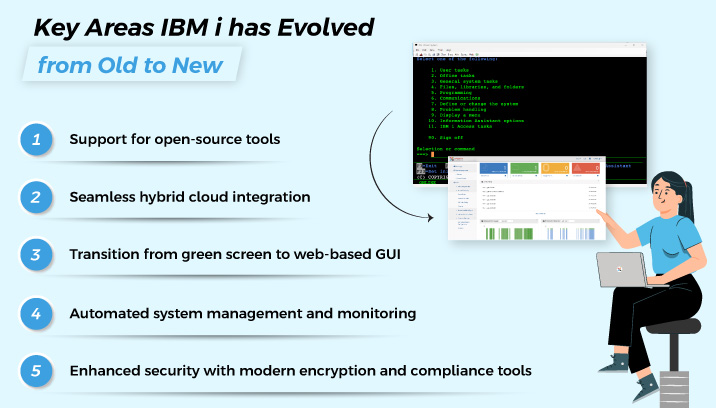
To truly understand this, we must look closely at how IT processes used to run 30 years ago. This will help us understand how and why legacy systems are still responsible for downtime in the current day.
For an average developer, such a code may be a head-scratcher. He may have to grasp the context of the code before cracking its meaning.
Yet, this method is not free of challenges. Hiring a clever coder may pose the following dangers:
The talent may not be up to mark.
The testing process may falter.
You cannot wholly rely on clever coders. The biggest issue is that they are here one day and go on the other.
The developer who devised your code may have changed their positions, left the company, or retired. While such coding may have benefitted you before, the IT team cannot devote time to coding for application dependencies without prompting unresponsiveness in another place.
Not just that, they also not take the risk of changing the older code. Since only one coder understands the whole thing, this option is not very practical in the long run and may lead to more complexities.
When it comes to testing, a whole new set of issues arise. There could be oblivion concerning testing the changes, running complete night processing, and re-running a single part of night processing.
If your IT team takes too much time making these decisions and attending to them, they are likely not responsive enough to the user community for a new report.
Thirty years ago, the idea of using homegrown scripts might have been a good one, but today’s developers work on solving business issues instead of investing time in reinventing things.
Agreed it’s a 30-year-old technology – but it is still reliable! Thinking what are the best use cases that AS400 serves to date? Let’s explore!
What is AS400 used for?
It is essential to explore the versatile capabilities of AS400 and understand how this robust system can empower your organization.
Data Storage
AS400 serves as a reliable and secure central data repository, enabling efficient data mining and analysis. With its robust infrastructure, AS400 can handle vast amounts of data, making it an ideal choice for organizations seeking a high-performing datastore.
From financial records to customer information, AS400 can effectively store and manage critical data assets.
Internet and E-commerce Services
Harnessing the power of AS400, organizations can leverage its web server capabilities to deliver seamless internet and e-commerce services.
AS400 offers a range of applications that facilitate tasks such as order management, order tracking, customer support, and supplier and warehouse management.
By integrating AS400 into your e-commerce infrastructure, you can streamline operations, enhance customer experiences, and drive business growth.
Enterprise Group Services
In addition to its core functionalities, AS400 offers a range of enterprise group services that can optimize internal collaboration and enhance productivity. These services include email systems, project file sharing applications, and fast collaboration.
Is IBM i Still Humming?
Yes, the AS/400, now known as IBM i, is still being used by companies today.
While many organizations have transitioned to more modern systems, there are still businesses that rely on AS/400, AS/400e, eServer iSeries, eServer i5, and System i platforms.
These older systems are often utilized for resource-intensive applications such as enterprise resource planning (ERP), banking systems, and medical information systems.
The hardware underlying these systems has evolved into the current IBM Power server line, which is based on Power processors.
The latest generation of Power servers, featuring Power10 processors, offers support for three different operating systems: IBM i (formerly known as OS/400), AIX, and Linux.
IBM positions IBM i as an integrated environment that combines an operating system, database, virtualization layer, application server, and transactional system.
These systems are designed to minimize downtime and support costs and can be deployed on Power Systems hardware or in the cloud.
IBM i running on Power servers has various applications, which include data management with the fully integrated Db2 database, software development using traditional languages like RPG, COBOL, C, C++, and Java, as well as modern open-source languages, tools, and environments for emerging technologies like artificial intelligence (AI) and the Internet of Things (IoT).
IBM i also provides access to IBM Watson for AI applications and supports IoT applications through open-source interfaces.
IBM i (formerly AS/400) continues to serve businesses in various industries, offering a stable and integrated platform for critical applications and providing support for modern technologies such as AI and IoT.
Who’s using IBM i?
It’s tough to estimate the actual number of IBM i users, but according to IBM’s previous calculation, around 120,000 organizations were using IBM AS400.
If we assume that the yearly base of IBM i users is shrinking at the rate of 3% annually, the figures set around 110,000 organizations using the software.
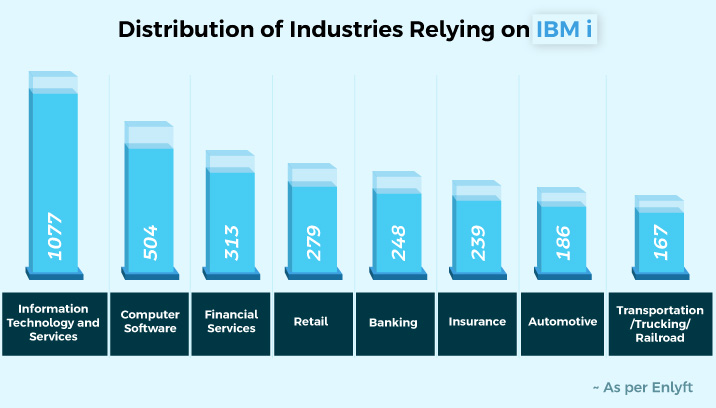
Now, that you’re aware of what IBM i is used for, what keeps if alive and who is using it, let’s understand the demographics of companies relying on it.
The Demography and Geography of IBM AS400 Installation
IBM has broken its marketing cap into two main camps, i.e., large companies with more than 1000 employees and small and medium-sized companies with less than 1000 employees.
According to IBM – “30% of IBM AS400 clients are large companies, and 70% business comes from small and medium-sized companies.” (IBM report, 2016)
According to the IBM, AS400 Strategy and Roadmap Report of 2016 – the IBM installation base is changing rapidly, and 70% of its business came from North America, Western Europe, and Japan.
In 2019, this percentage changed, and the number increased to 80%.
This data clearly shows that the market expansion is boosting sales, and in countries like Japan, which is the largest market for IBM AS400, organizations are spending millions on this platform.
Moreover, IBM AS400 is not known by these markets only, as the company has noticed continuous growth in Eastern Europe, Latin America, and the ASIAN region. Although China has dominated those markets, IBM AS/400 has continuously been evolving, especially in the banking and distribution sectors.
Why is IBM iSeries Infrastructure Important?
IBM power system, iSeries, and AS400 are developed keeping in mind the future developments in the technology field so that it’s easy to implement in the IBM ecosystem.
There are some specific features/characteristics of IBM iSeries systems that make it important for your company.
Extract Powerful Solutions
Using IBM-based infrastructure for your company will help you extract robust solutions for all your complex business needs. Your developers and experts will have robust options to manage your entire business ecosystem with finesse.
There will be limited limitations when it comes to deriving solutions for your business. It will help you to achieve your business goals more easily.
Many Integrated Features
You can cover all the complex tasks like networking, security, storage, and database with integrated features of IBM iSeries.
It helps to seamlessly manage all the tasks, leverage the resources’ scalability, and achieve your business outcomes with minimal workflow leaks.
Supports Multiple Open-Source Technologies
IBM i supports a wide range of open-source technologies like RPGLE, RPG III, RPG IV, CLP, CLPLE, C, C++, Php/JAVA, DB2/400, MSSQL, DDM, LPAR, JVM, ODBC/JDBC for Java, .NET, RPG-XML, JSON, among others.
You can install all the packages available in the RPG package format systematically. With the ability to work and integrate the latest technologies, you can create modern-day applications to tackle dynamic problems.
These are some of the standout features of IBM i that you can use for your company, but before that, you need to decide who will manage all the IBM iSeries infrastructure operations.
Now, that you know why IBM iSeries infrastructure has an important role to play, let’s understand about top utilities offered by IBM i software.
Top Must-Know System Utilities of IBM i Software
Are you aware of the features and functionalities of your IBM iSeries software? Or do you know how to plan and manage the ongoing operations on your IBM as400?
IBM i can handle many tasks automatically, whereas another OS requires a team to handle similar tasks. IBM iSeries AS400 always emphasis on security, software management, and problem-solving approach. Get an introduction to system architecture and built-in functions through this blog.
Have a look at top ten IBM AS/400 iSeries utilities that can give you a boost in system administration:
History Log
Since starting, if the system has been shipped with the value QHSTLOGSIZ set to 5000, it means the number of records allowed in a single QHST log file before moving to another one.
Previously there happens to be very little activity onto the system, so 5000 was the best limit. But in today’s scenario, we’ve thousands of users using our system and data in multiple ways. Moreover, it’s a fact that more and more information is being uploaded on the IBM AS400 iSeries system, which denotes the formation of a new QHST file every minute.
Message Queues
IBM as400 i-Series is excellent at logging events, and that mostly goes to the history log or message queue. But you should be aware that the message queue is capable of holding only 75,000 messages. In the absence of proper maintenance services, more messages in the queue can result in the process stopping.
System value QJOBMSGQFL allows users to dictate at the system level and decide what will appear on the screen when a queue is full. The system value is denoted through – *NOWRAP command, which means “do not wrap.”
If you rely heavily on the QSYSOPR command, keep in mind that this queue is clear at IPL time and can wipe your entire audit trail.
CRTMSGQ MSGQ (QSYS/QSYSMSG) – This command can be used to create a message queue.
Disk Space
Large IBM AS400 iSeries organizations often find that their disk space grows 30% every year organically, but they cannot figure out what is growing and what can be done with these growths.
The IBM iSeries AS400 system automatically shows the code CPF0907, which denotes serious storage conditions and QHST when the system auxiliary storage pool reaches a threshold. This threshold limit can be defined within the system service tools. Apart from these, you won’t get any other notification in real-time for library size and disk space.
However, these two IBM as/400 iseries commands can give you some insights about what’s occupying the space:
RTVDSKINF – Retrieve Disk Information
This command must be entered into the batch and at a specific time within the system. The command analyses all the functions and collect data from each section, like disk percentage, last used, last changes, and many more.
PRTDSKINF – Print Disk Information
This command works in parallel with the RTVDSKINF command. Once the process of retrieving disk information is completed, you can freely extract data through the Print disk. In general, the command focuses on accessing data from libraries, folders, objects, system information, and areas of interest.
Memory
Theoretically, you may run the overall application in memory on POWER8, but memory comes at some cost, and you should closely manage it.
The system value QPFRADJ (Performance Adjustment) is conveyed and manages system memory pool size. Moreover, it actively levels the number of threads that can be used by the processor when needed to attain optimal performance.
Furthermore, if you use the key, you can knob around to see active and ineligible values. Generally, these values should be zero, and any value other than this indicates that the thread has been waiting or active earlier. In such cases, deep analysis is advised.
Exit Points
System administrations often don’t pay attention to IBM iSeries AS400 exit points, apart from the critical position holders who want to shine a light on gaps. In IBM i 7.2, there are 133 exit points (the paths through which controls are passed to one or more programs).
Out of these 133 exit points, you only need to take care of 27 points. Out of these 27 points, only 12 points provide access to the system and data. Are you aware, who is accessing your system, and what are they accessing?
Object Size
There are no management services available in the IBM AS400 iSeries system to manage the IFS to overgrow. One GB of integrated file system (IFS) object takes longer to save & restore than one GB large IFS object. So, users must be aware of large and small IFS objects that have not been used for a long time.
There is a small limit of 360000 objects allowed within a library and in the QSYS.LIB file system. The application will continue in normal mode after the limit is crossed, but you won’t back up the library after that.
When thinking of saving the library, the IBM AS/400 iSeries system doesn’t generate a warning apart from “CPF3770”, which typically means no object saved or restored.
Spooled Files
The WRKSYSSTS command displays the “JOBS IN SYSTEM” figure, and it consists of all the jobs queued together, out of them how many are currently running and how many of them have spooled files.
IBM iseries as/400 look of each job into the system to stick to how jobs are available and how much time it will take to manage the system.
Job logs and as400 system output can be managed effectively by the options given in the operational assist menu, and there you can also define the number of days to keep the spooled files.
Journal Receivers
When system availability is the priority of every organization, it’s common to see high availability applications within the organizations. Many of these organizations use journaling to keep the standby systems coordinated.
Journal receivers can grow to a large extend in a short period, and it’s common for journals to process 300,000 entries per minute.
Runaway or Looping Jobs
IBM AS400 system has numerous switches and controls that permit users to manage the system in a way they want and handle various workloads simultaneously. However, there is still room for improvement in the system, especially for looping jobs. These jobs make use of unnecessary system resources and impact the end-user experience negatively.
Elevated Profiles
Total four user profiles are sent with access to all IBM AS400 iSeries system objects:
QLPAUTO
QLPINSTALL
QSECOFR
CSS
Have a look at your IBM AS400 system and check if you still have all these profiles with ALLOBJ* (special authority).
In our years of services, we’ve experienced that it’s easier to copy and modify an existing profile than to create a new one, and that’s the reason many companies consider existing user profiles. As a result of this, many companies end up collecting hundreds of robust profiles.
Sometimes, files with ALLOBJ* authority happen to be group profiles.
That’s it about IBM i software utilities! Now, let’s discover how IBM AS400 helps you uplift your business processes. Let’s go!
How IBM AS400 Helps Upgrade Your Business Processes?
If you are running an IT company that still uses IBM AS400 servers, then we’re sure that the thought has probably crossed your mind that you could benefit from an upgrade, i.e., from AS400 to IBM iSeries.
In this tight global economy, it is often challenging to move to a new platform.
In the worldwide market, a server will cost you around $30,000, and if you have that kind of a budget, it’s better to upgrade the existing AS400 server to an iSeries or a Power system that comes with a wide range of benefits.
If you are prepared for the server upgrade, keep in mind that after going live on the new server, you can save up to thousands of dollars.
Are you thinking about how? It can be in the form of power-saving, processing speed, decreased hardware maintenance and eliminated downtime.
Let us explore each area thoroughly –
Power Savings
This phenomenon is elementary as the new servers are designed to consume less electricity and deliver more power. Moreover, the new iSeries server generates less heat, resulting in lower air conditioning costs in server rooms and data centres.
Processing Speed
It is not easy to put a dollar figure on the benefits of having new servers. But think it another way- when you will get 5 to 10 times the processing speed from your servers, the productivity impacts will increase throughout the organization.
The IBM i servers offer a significant commercial processing workload (CPW) per dollar. When customer queries are resolved in half time, stakeholders can quickly make decisions.
It will also reduce the month-end close time so that all the employees in an organization can get the numbers earlier. In an organization, everyone from the manager to accountant and distribution coordinator will access information quickly and get reports faster. Such benefits will pay out every day.
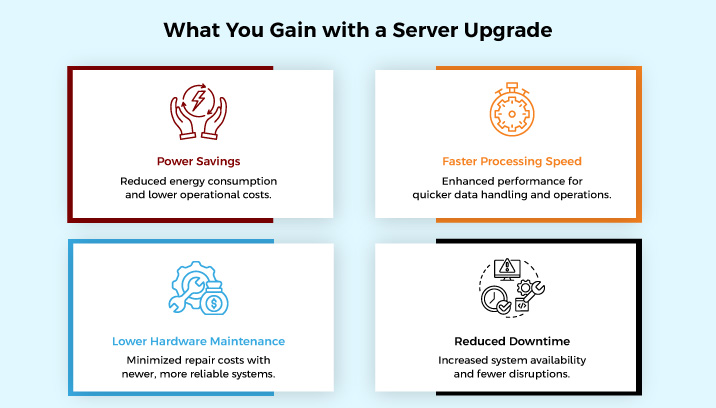
Hardware Maintenance
Old servers are like old cars. Your 1990 model car still starts whenever you go for a drive, despite the total distance traveled till now. But when you go for repair, you’ll not notice the smaller tweaks; instead, you will look for the complicated and significant issues that are not easy to fix and require highly experienced mechanics. IBM AS400 servers work in the same way, and they are harder to improve too.
Downtime
Often, the AS400 servers have a short mean time in terms of failure, as the old servers cannot run the latest version of each OS. Moreover, they will not deliver the latest features and functionality that users generally crave within the system’s functioning. Furthermore, it would be best to forget that older machines require more downtime for repair, leading to disturbing business processes.
Done & dusted? Past is gone! The present is booming! What does IBM AS400 hold for you in the future? Let’s explore!
What IBM AS400 iSeries Holds for your Business’ Future?
From a midsize organization to large manufacturers, retailers, and banks, many organizations use IBM AS400 for their smooth business operations.
Furthermore, you can also find IBM AS400 in government institutions. Everyone is using AS/400, but at some points, they are concerned about the future, as IBM keeps making changes continuously.
Read ahead to understand what the future of AS400 holds for you.
The Next Steps of IBM Strategy
IBM has announced to support IBM AS400 iSeries, IBM AS400, IBM i, through 2032.
This 13 year strategic roadmap is enough to tell any CTO that IBM is not walking away from its OS anytime soon. IBM will support the latest version of IBM i OS – 7.2, 7.3, 7.4 until 2022, 2023, and 2026.
Essentially, IBM promises its customers that applications running on the old version will continue to run on the OS’s future releases. This statement is enough for CTO’s to sleep well at night.
The IBM AS400 of Tomorrow
What kinds of features and capabilities can we expect in the future IBM i releases? This is the most common question as IBM itself is heading towards the next technology upgrade after the delivery of IBM i 7.4.
However, we have created some educated guesses from IT business trends that we would like to see in the future.
For starters, don’t be stunned if IBM AS400 adopts the cloud-native virtualization technology known as containers at some points.
For this, we can take the example of Intel’s X86 world, companies are quickly adopting Docker and Kubernetes, a containerization runtime and orchestrate containers.
Together, these both make it easy for organizations to create, scale, move, and destroy server OS without concern for the available hardware setup.
This is possible; all the necessary elements are already available in the container. Similar technology could be implemented in the IBM AS400.
IBM Power Systems Hardware is Changing
Things are moving towards good on the hardware front also. Work is on-track with regards to the future generation of Power11 processors, which is in formative stages.
If IBM continued the track record of launching products on time, we would see Power11 in the market in 2024. There is not much to speak about Power12; however, we can assume that it will be delivered somewhere between 2027 or 2028.
Undoubtedly, we will see a lot of exotic processors offered in Power Systems within the future. IBM features a partnership with Nvidia for graphics processor units (GPUs) developed to Power high-end graphics for video games.
However, now they are utilized as co-processors in supercomputers. GPUs are being adopted to Power advanced “deep learning” systems that are used for image recognition techniques and handling (NLP) workloads.
We will additionally see different specialized processors, like field-programmable gate arrays (FPGAs) within the hardware mix.
The Gamechanger – IBM AS400 Cloud
IBM AS400 cloud could be the biggest game-changer.
The IBM AS400 community has had multiple cloud options available for many years, but they all are private.
However, it is on the brink of getting the primary options for native public clouds from IBM, Skytap, and Google. These clouds will enable users to make IBM AS400 instances that they will rescale as needed through a web interface.
All these public IBM AS400 cloud options will dramatically impact the way organizations use IBM AS/400 and its resources. Moreover, there is nothing wrong with grouping the IBM AS400 with future technologies, as the potential of this technology is enormous, and it will grow dramatically.
Furthermore, this grouping will be a boon for the vendors offering SaaS services. However, there is a need to change traditional IBM AS400 licensing agreements that aren’t compatible with the method business is done on the cloud.
Hope this gave a sneak peek into what the future holds for you with IBM AS400. Let’s look at the top trends in IBM i space you should care about!
Top IBM i Trends to Watch For
IBM i involves higher upfront costs compared to other platforms. The initial investment includes hardware, software licenses, and specialized skills required to manage and maintain the system.
However, it is important to consider the long-term cost efficiency and the value provided by the platform in terms of stability and scalability.
IBM i is a specialized platform, requiring a specific skill set for development, administration, and maintenance.
Finding qualified professionals with expertise in IBM i can be a challenge, which may impact resource availability and recruitment efforts.
Organizations considering IBM i should evaluate their access to skilled resources or invest in training existing staff.
As we venture deeper into the digital era, various trends significantly impact the IBM i and AS400 market. Keeping abreast of these trends will help you effectively navigate the evolving landscape and optimize your use of these systems.
Let’s look at the major trends impacting the IBM i and AS400 market –
Digital Transformation/Modernization
More and more businesses are undergoing digital transformation, leveraging technology to streamline operations, enhance customer experiences, and foster innovation.
The IBM i is critical in these transformations with its robust capabilities and wide-ranging functionalities. For example, a manufacturing company might employ the IBM i to digitize its production line, achieving greater efficiency and accuracy in its operations.
We focus on evaluating the existing applications running on the IBM i platform and identify opportunities for modernization. This may involve rewriting code, adopting new development frameworks and languages, and incorporating web and mobile interfaces to improve user experiences.
We also can get into integration between IBM i applications and external systems through web services and APIs. This facilitates seamless data exchange, collaboration, and interoperability with other applications and platforms.
If you need data analytics or business intelligence, we help you leverage the data stored on the IBM i platform by implementing these solutions.
We can develop mobile applications or optimize existing applications for mobile devices, allowing users to access critical business functions on smartphones and tablets.
You can embrace DevOps practices to streamline application development, testing, and deployment processes. We can help you implement continuous delivery pipelines to accelerate software releases, ensure quality, and promote collaboration between your development and operations teams.
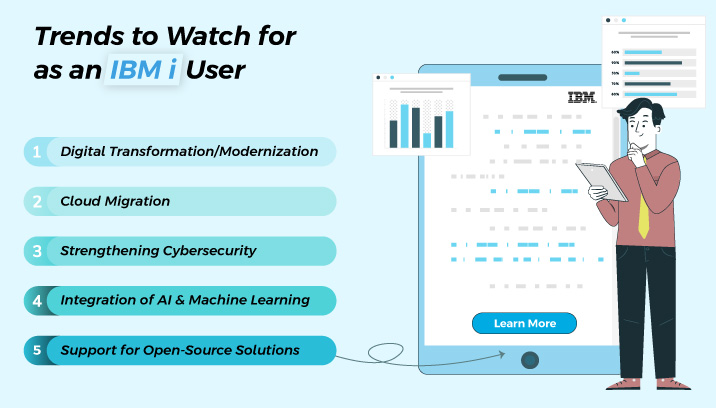
Cloud Migration
The shift towards cloud computing is another significant trend. Companies are now exploring options to host their IBM i and AS400 systems in the cloud. This provides the benefits of reduced IT costs, improved scalability, and access to advanced cloud-based services.
For instance, a retail business could move its IBM i-based inventory management system to the cloud, enabling real-time inventory tracking across multiple locations.
Migrating AS/400 applications to a modern platform requires careful planning and execution due to the complexities involved.
The way we approach it is by conducting a comprehensive analysis of the existing AS400 application to understand its architecture, dependencies, and functionalities. And then the components that need to be migrated, while evaluating any potential challenges or limitations.
We engage with your stakeholders to gather requirements and identify the desired functionality, scalability needs, user interface improvements, and integration requirements with other systems or services.
We evaluate the existing AS/400 codebase and determine whether certain parts need to be rewritten or refactored to align with modern programming languages and frameworks.
We redesign user interfaces to enhance the user experience and meet current design standards.
Lastly, we develop a strategy for migrating data from the AS/400 system to the modern platform. Plan for data transformation, cleansing, and mapping to ensure data integrity and compatibility with the new environment.
Cybersecurity Focus
With cyber threats becoming increasingly sophisticated, there’s a growing emphasis on securing IBM i and AS400 systems. To safeguard their IBM I environments, businesses invest in advanced security measures, including data encryption, intrusion detection systems, and regular security audits.
We can strengthen security measures on your IBM i platform to protect against cyber threats and comply with industry regulations.
AI and Machine Learning Integration
Artificial Intelligence (AI) and Machine Learning (ML) are increasingly integrated with the IBM i. These technologies can help automate routine tasks, provide predictive insights, and enhance decision-making processes.
An insurance company, for example, could use AI algorithms on its IBM i system to predict future claim trends and adjust its policy pricing accordingly.
You can explore the integration of AI and automation technologies into IBM i applications.
This can include leveraging machine learning algorithms for data analysis, implementing chatbots for customer support, or automating repetitive tasks to improve efficiency.
The Rise of Open Source
The IBM i and AS400 also see increased integration with open-source software. This trend allows businesses to utilize various innovative, community-driven software solutions in their IBM I environment.
Understanding these trends will equip you to make the most out of your IBM i and AS400 systems. But, capitalizing on these trends requires efficient management of your IBM i infrastructure.
By now you must be convinced that the cloud is the future, right? Contemplating what makes it a great deal? Read further to explore!
Why Consider Migrating Your IBM i Applications to Cloud?
Business applications are vital to keep your business progressive in the fierce era of technological evolution.
They control business cycles and assist you in collaborating with customers and clients.
Creating applications that automate your redundant tasks or make things faster and better enables your organization to improve and contend in the market.
Be it any platform, applications give you an extra edge, and here we talk about how IBM Power Systems applications provide extra benefits to lots of companies due to their abilities.
However, managing the IBM AS400 applications in-house can be risky to handle.
But cloud hosting is the best alternative for application management.
Our IBM i clients tell us that they are worried about providing continuous services to their users. And this is a common phenomenon that we hear about, specifically in the North American region.
While they may have several options to continue their business services if they come across an issue, but still waiting for support services can be time-consuming, and it’s too expensive when downtime occurs. In such a scenario, again, cloud hosting is turning into an attractive option for IBM applications.
When IBM i clients assess their choices, they are amazed to find that cloud hosting at an SSAE-18 is more dependable and tech-savvy compared to the current on-premises setup.
Companies using IBM Power Systems should consider moving their application to IBM cloud setup to unlock more features.
Have a look at the six most important reasons to understand why you should migrate your setup to IBM AS400 cloud.
Save Money
In comparison to server management (on-premises), IBM AS400 cloud is 30%-70% cheaper.
This is because IBM’s Power servers have more capacity and resources than the needs of IBM i users.
If you rent a server or hosting, you can save around $3,000 – $15,000 per year by IBM AS400 cloud hosting. Cloud hosting not only eliminates the need to purchase a server, but it will also eliminate the cost of hardware and software maintenance and the cost of the IBM licensed program.
Companies get regularly approached by businesses who have already hosted their IBM AS400 on the cloud, as they find it cheaper.
IBM AS400 Expert Support and Backend Service Management
Potential cloud users think that the talent pool of IBM i is shrinking, the employees are retiring, new employees are not familiar with the scope of business, and consultants are leaving the field.
That’s why it is hard to find a talented replacement. Furthermore, many IBM AS400 related service and support companies are run by experts in other fields, and they need enhanced technical support from IBM i experts.
As a conclusion to this, you can say – hosting with expert IBM AS400 cloud providers make you confident that your applications are safe, and support is available instantly.
Great Security, Redundancy and Disaster Resilience
Centralized data centers provide enhanced security in comparison to what most companies can provide.
Generally, data centers have redundant power, secure physical access, internet access, and many more world-class features. Server hosting at data centers can range somewhere around $1000-$3000 per month.
By hosting your applications on an AS400 IBM cloud, you will get benefits like security, disaster resilience, and redundancy at a very minimal cost.
New Technology Access
Cloud hosting will allow you to upgrade your IBM AS400 to the newest Power Server and open the doors to the latest OS level, while enabling you to use the latest hardware, features, and systems enhancements. This way, you will not need to be concerned about repurchasing a new server.
No Major Capital Outlay
Shifting to a new server is seen as a capital investment by several organizations, and it also requires various approvals, while IBM AS400 cloud hosting is an operational expense.
And companies have discovered that it’s easy to get support for operating costs than a capital investment.
Flexible Terms
On IBM AS400, cloud hosting terms are far more flexible in comparison to buying new hardware. For example, new software purchase is made by considering 3-5 years of operation time, while hosting terms can of a month, quarter, year, or maybe a duration that meets your needs.
Still uncertain of what you gain with this transition? Let’s understand the sheer value of moving your IBM i applications to cloud.
The Value of Migrating Legacy Applications to a Cloud Setup
As businesses are growing in this digital world, the right cloud migration strategy and its deployment in the right way can improve business results.
A flexible and hybrid cloud setup can provide modern ways to manage applications, increase transparency in business operations, and reduce security failure risks.
By allying workloads with optimal IBM AS400 cloud, organizations can optimize the cloud deployment more effectively.
In addition, an upgraded cloud base application will help you manage infrastructure, business complexities, strengthen insights and increase ROI through technologies like AI and IoT.
Only you can transform your business by co-creating the strategies with a certified IBM i cloud services provider.
Unsure if all of your mission-critical applications can be moved to the cloud with no-to-low disruption? Hybrid Cloud has you covered! Read further to know more about it.
What is Hybrid Cloud in IBM Power Systems?
By now, we’ve all heard of “The Cloud” only, and some of us may have heard of IBM Power Systems in the IBM Cloud. When “Cloud” was introduced, many experts said, “It’s nothing new in the cloud; it is just running something somewhere on someone else’s computer and accessing the data through the internet.”
The promise to move your workload to the Cloud is tempting; once you somehow move your application to the Cloud, someone else will manage it for you, and you will save on costs on your on-premises data center.
However, moving workloads to the Cloud was not accessible due to the lack of warranty operations, pricing, cloud support, or a virtual machine with a selectable SLA in the Cloud.
But today’s cloud computing is new because IT organizations can now quickly move their workloads to the “Cloud.”
There are many clouds services providers, such as Google (GCP), Amazon (AWS), Microsoft (Azure), or IBM Cloud (formerly known as SoftLayer) and many others, that offer modern “cloud” capabilities such as:
- Onsite Support
- Huge Storage Capacity
- Cloud Server Management
- Automatic Dynamic Capabilities
- Protection
- Definable Service Level Agreement
All of this felt good for C-Suite because they believed they could reduce the size of their data center infrastructure, the complexity of operations, operating system, device management, and can define their service level agreements. The Cloud seemed to offer higher cost savings and lower risk, and their headaches were gone.
First, let’s understand what hybrid cloud is.
What is Hybrid Cloud?
Suppose you are the owner of a large organization with mission-critical workloads. You like the idea of moving some management workload, risky operations, and expensive upgrades to the Cloud.
What do you do now?
Well, the final idea is a hybrid Cloud.
This may sound scary, but it means to use the Cloud for essential tasks and leave data center systems and staff to manage critical functions within the organizations whose needs can’t be fulfilled in the Cloud.
Some system requirements, such as high-security standards, hardware data replication for HA / DR, high-security network bandwidth, and regulatory compliance, can be challenging to implement on the Cloud.
However, not all application areas in all IT environments have these mission-critical requirements.
The common thing in these examples is that they are mostly used in large companies, are not mission-critical, use dynamic capabilities. The system resources used to meet needs are not used for a long duration.
It should be an easy and successful way to access the Cloud. Moving an application segment to the Cloud as proof of concept is of great benefit in learning and testing the Cloud, and it reduces overall IT costs.
It can increase dynamic usage with fewer security issues.
Hybrid Cloud and IBM Power Systems
Today, IBM Power Systems are very popular and used in thousands of well-known companies we interact with every day. These companies include banks, medical institutions, large retail chains, transportation companies, etc. The organizations use IBM Power Systems for reliability, efficiency, safety, and demand management.
The IBM Power Systems are running on AIX and Linux and are a great success. Clients run 15 TB DB2, Oracle, SAP HANA, and EPIC databases and have extensive networks with very high bandwidth requirements that power systems can easily support. They have highly secure environments and HA / DR solutions using IBM Power HA system mirrors and use IBM’s leading technologies such as PowerVM, PowerVR, and PowerSC to improve their environments.
All these power system technologies are available in IBM Cloud Power VS. IBM Power VS may offer the same capabilities that power systems businesses use today. Still, they can also take advantage of cloud applications and not give up their on-premises abilities.
IBM Cloud with Power Systems is the highest security rated Cloud and uses the best hardware security built into the industry. With Power VS, IBM Hybrid Cloud also offers capabilities not found in other clouds, such as mass data migration tools, Aspera for high-speed network data transfer (compressed and encrypted), and the ability to use OVA technology to capture and migrate VM workloads.
Getting Started with Hybrid Cloud
Customers can migrate to the IBM Hybrid Cloud where IBM Power Systems 922s and 980s live with IBM 9100 storage systems and are provided with AIX, IBM i , or Linux based on their custom applications and can replicate the on-premises environment.
Yes, but how will it work?
And HIPAA, PCI, GDPR, etc. What if similar standards are too strict for many other cloud providers today? On IBM Cloud Power VS, many of these compliance rules have already been standardized, and ISVs, such as SAP, have also certified the implementation of the IBM Cloud Power System.
Also, Hybrid Cloud is a better option as it saves you from the pain of migrating to a cloud environment when there is a risk of reversing (i.e., returning to premises). Start with Hybrid Cloud (PoC) for development/testing or HA and then expand.
Moreover, follow a phased approach to selected applications while maintaining a critical workload in the workplace.
Consider moving additional components such as DR, data storage, and the IBM / HCL WebSphere application server interface to the Cloud and allowing them to connect to on-premises applications that require performance, security, and mobility.
After Effects of Full-fledged Cloud Migration
The reality today is that cloud technology still needs to make significant changes to meet the expectations of organizations.
One survey suggested that 38% of those who moved their workloads to the Cloud found that cloud application is not capable of fulfilling their needs, and they had to switch back to on-premises solutions, but reverse migration is more expensive.
Small businesses can run individual applications with lower security risk, minor performance issues, and minimal capability requirements, and this is the tendency for customers to succeed.
However, large organizations with complex IT architectures and mission-critical applications did not find what they wanted. So, they had to go back. The survey also found that 38% of those who returned did so at a higher cost.
Further in this discussion, we will discuss how technological advancement can help fix inefficiencies, making the Cloud more convenient for many businesses.
Eventually, it’s called “application modernization.”
Thinking why to take that route? Here’s why!
Why Consider Application Modernization?
Application modernization helps you solve major cloud issues. Moving applications into a containerized microservice environment and executing them through Kubernetes will solve many performances, reliability, scaling, development/testing, HA / DR, etc.
This environment is perfectly managed using Red Hat OpenShift, where containerization is available for small services and K8S and is mission critical.
Red Hat OpenShift is also available in the IBM Power VS Cloud today and can start exploiting as a development/testing environment and lead to a modern production environment aligned with the capabilities of the IBM Hybrid Cloud.
Red Hat OpenShift can support the on-premises environment and IBM Hybrid Cloud environment as well.
Additional capabilities for data management, administration implementation, and AI extensions include Red Hat OpenShift as a base called IBM Cloud Paks, specifically IBM Cloud Pak for data, IBM Cloud Pak for security, and IBM Cloud Pak for multi-cloud management. These can add a successful cloud experience.
What is IBM i Application Modernization?
When technology or software system ages, their capabilities tend to deteriorate, which can have a negative impact on an organization’s ability to run without interruptions.
Aging legacy systems can also impact customer experience, which can influence how customers perceive a specific brand or service. Fortunately, businesses can catch up with advanced technology without spending a fortune on completely new systems.
IBM i application modernization is an affordable solution for lowering IT expenses while increasing flexibility and productivity. It is the process of repurposing legacy software applications to better meet the demands of a business.
When tech solutions become old or outdated, it can be a serious impediment to technological advancement in enterprises. Outdated platforms might be difficult to use and could have features that are no longer compatible with newer technologies.
Therefore, to keep legacy software applications running smoothly, businesses might need to make necessary updates.
What Are the Bottlenecks of Legacy Software?
Legacy systems such as the AS400 iSeries have been the cornerstone of many industries for over 30 years, particularly those involved in manufacturing, transportation, and freight. Businesses in such industries must analyze massive amounts of data, which necessitates using a powerhouse like the iSeries platform.
The iSeries systems are reliable to work with. IBM, the system’s creator, has been sustaining the hardware aspect of it by releasing the latest versions with additional efficiency under the hood.
But regardless of hardware upgrades, IBM i software support service is limited to OS and other basic updates. One of the major shortcomings of the iSeries systems is the software developers who were in charge of administering and maintaining them. They are either about to retire or have already retired.
Furthermore, AS400 iSeries systems include 5250 green screens that demand modernization. CTOs are now in a pickle because millennial developers understand advanced technology but not RPG. This leaves the CTOs and CIOs with only two possible choices:
Move away from the iSeries framework completely.
Employ the services of a third-party company that can support legacy systems.
The first alternative is easier said than done. The iSeries systems are already reliable to work with, and there’s always the fear of the unexpected.
Working with iSeries for decades and then transitioning to a whole different technology can be quite frightening. The nightmare, however, does not end there. Another pain in the neck is data migration from DB2.
Migration, in addition to its various advantages, carries vulnerabilities that, if not handled carefully, might have catastrophic consequences.
Because of the fear of change and unfamiliarity, most leaders of tech companies are hesitant to migrate from on-premises servers to the cloud.
But what if there’s another option that is not only viable and affordable but timesaving too?
Why Consider IBM i Application Modernization for Legacy Systems?
Here are a few key advantages of IBM i application modernization for legacy applications:
Incorporate new features
When a company first acquires software, it often selects a platform that satisfies its current needs without regard for the far future. Companies, on the other hand, are always evolving and adapting to new and emerging technologies.
When existing and old software applications become outdated, organizations may find it challenging to keep meeting the expectations of current clients.
However, suppose businesses go for application modernization services. In that case, it will enable them to develop and incorporate new features and services that are more in alignment with their current needs and future business goals.
These additional features can be tailored to the needs of the organization to ensure that the legacy system continues to provide worth.
Improve Staff Productivity
Staff productivity is one of the most critical aspects of IBM i application modernization that is frequently neglected.
Developers and administrative personnel are generally more productive when they have access to technological solutions that are simple to use and avoid time-consuming tasks.
Application modernization can assist automate work processes and eliminating repetitive tasks, allowing staff to make better use of their time.
A modernized platform can also result in fewer system issues, high efficiency, and more capabilities aimed at streamlining business processes.
Eliminate Technical Debt
Maintaining outdated IBM legacy software systems can be an expensive affair.
As per market research company Vanson Bourne, organizations who took the necessary measures to upgrade their old IT systems lowered their operational expenses by 13%.
In addition to lowering operational expenses, application modernization has the potential to increase yearly revenue by more than 14%.
Therefore, savings can be made by eliminating technological debt without purchasing whole new software systems. Businesses that use a modernized system save money on maintaining obsolete technology while encountering fewer problems overall.
Improve Customer Experience
In terms of customer service, running an AS400 iSeries legacy application may appear inconsequential. Continuing to operate an old technology, on the other hand, can have an adverse effect on the customer experience.
Customers want businesses to keep up with new technologies and trends. Failing to do so, businesses risk losing their potential customers to rival companies.
However, with IBM i application modernization, organizations can improve the customer experience through several changes, such as:
- Transforming the front-end user interface
- Adding new features
- Launching new services
- Automating previously manual operations
Create new Opportunities to Develop Additional Sources of Revenue
Modernization of IBM i software applications can help create opportunities for additional sources of revenue.
When an organization decides to modernize its systems, it creates the opportunity to develop new workflows or solutions that provide extra value to its clients.
Outdated legacy applications are typically inflexible, restricting organizations from making the necessary updates to make lucrative improvements.
As a result, incorporating new solutions or processes leads to increased customer satisfaction and higher profitability. And if clients are satisfied, they are more inclined to promote a company, resulting in more leads.
We hope that these points were satisfactory enough to make you consider modernization.
Now, as you decide to move forward with IBM i application modernization, how would you approach it? Would you prefer doing it in-house or hire an IBM i technology partner to modernize and manage your IBM i ecosystem?
Thinking about what makes better sense? Read ahead!
IBM i Management – Should You do it In-house or Outsource?
Navigating the IBM i landscape can be complex. However, efficient management of this system is crucial to extract its maximum benefits. Businesses generally adopt one of two strategies: In-house management or outsourcing.
Let’s delve into both strategies!
Manage Your IBM i Applications In-house
Let’s first look at the advantages of managing your IBM i applications in-house.
Control
Managing IBM i in-house gives you direct control over your systems. This approach allows your team to tailor the system to your unique business needs. For instance, a healthcare provider might have specific data privacy requirements; an in-house team can ensure these are met.
Knowledge Retention
In-house teams develop a deep understanding of your IBM i environment over time. This accumulated knowledge can be invaluable in resolving system issues quickly and efficiently.
Instant Response
An in-house team can respond instantly to any issues that arise, minimizing downtime. This quick response time can be critical in industries like e-commerce, where even a few minutes of downtime can lead to significant revenue loss.
Now, let’s understand the challenges that may cross your path while managing IBM i applications in-house.
Cost
Hiring and training an in-house team can be costly. Additionally, the expense of keeping your team updated with the latest IBM i developments and trends can add up over time.
Scalability
As your business grows, your IBM i environment must scale accordingly. This can require substantial resources and expertise.
Now, as we’ve gone through the positives and negatives of handling your IBM i applications in-house, let’s take a look at the other side of the coin.
Working with an IBM i Technology Partner
Let’s first look at the advantages of working with an IBM i technology partner.
Expertise
When you outsource, you gain access to a team of experts with extensive experience and knowledge of the IBM i. They can bring best practices from across the industry to your business. For instance, a financial services firm might outsource to leverage the provider’s expertise in implementing robust security measures on the IBM i.
Cost Savings
Outsourcing can be more cost-effective than managing your IBM i in-house. You save on hiring, training, and retaining an in-house team and can instead focus your resources on core business activities.
Scalability
An outsourcing provider can quickly scale your IBM i environment as your business needs change. This can particularly benefit businesses in high-growth industries, like technology startups.
Well, working with an IBM i technology partner also has its own set of challenges. Let’s take a look at them.
Less Control
When you outsource, you may have less control over your IBM i systems. However, this can be mitigated by clear communication and setting explicit expectations with your outsourcing provider.
Dependency
Outsourcing can lead to dependence on the provider. However, this risk can be managed by ensuring a proper contract is in place, outlining the responsibilities of both parties.
Bottom line – Each strategy has merits; the right choice depends on your business context and needs. If you’re considering outsourcing, it’s essential to choose a provider who can offer not just expertise but also a partnership.
Why Working with an IBM i Technology Partner is Worth it?
When it comes to the professional management of IBM iSeries, you have two options on your side. Either you need to hire an in-house team or outsource your management to third-party professionals.
Compared to hiring an in-house team, outsourcing is a more realistic and cost-effective way for you to create a solid and result-oriented IBM ecosystem. Here’s how:
Save Your Time, Energy, and Costs
Once you decide to outsource, you save all the time, energy, and expenditure that might be drained when hiring and training your team of IBM professionals.
You don’t need to individually look after all the team members to ensure they deliver the best outcome for your brand.
You escape all the hassles that will help your core team look after more creative business without worrying about the IBM iSeries infrastructure management.
Boost the Overall Productivity of Your Team
Productivity is one of the core aspects; you’ll improve it by outsourcing rather than hiring an in-house team.
You’ll get an experienced team of IBM experts who have already helped multiple clients enhance their business processes by better managing their IBM iSeries infrastructure.
It will help you to get a better optimized IBM i environment and skyrocket your business outcomes.
You won’t have to put in much effort to boost the workflow because the outsourced team will work with dedication within the promised deadline because they have to maintain a reputation in the market.
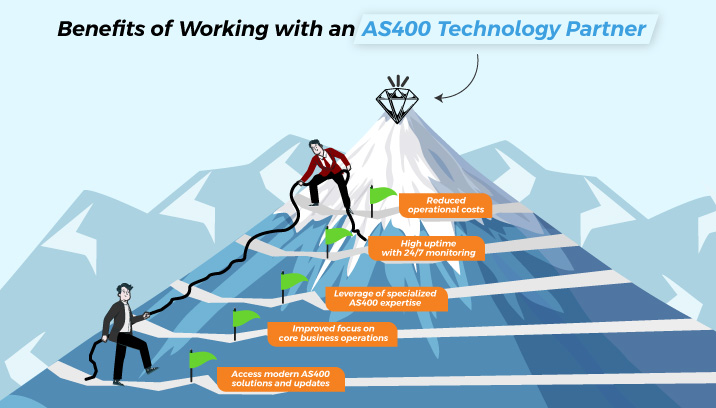
Add Flexibility and Scalability
You’ll have a wide range of flexibility and scalability options if you decide to outsource your IBM power systems management and operations.
With smoother workflow and robust management, you can bring versatility to your business solutions and scale your existing IBM ecosystem.
You can draw the most out of your iSeries systems and achieve your business outcomes without worrying about the technical aspects related to management and integration.
Embrace Creativity and Innovation
When you hire an in-house team of professionals, your count will be limited due to budget restraints.
But with outsourcing, you’ll get a large well-equipped team of IBM professionals, which will help you add technology advancements and implementations.
You’ll have different perspectives and angles so that you tailor a more packaged solution for your IBM iSeries infrastructure.
Improve Security Stature
You’ll have more focus on the security options with a third-party IBM iSeries team as they will ensure no unwanted external breach happens to your infrastructure.
Because they don’t want their client to suffer losses just because of the security lapse in their operations.
While in the case of employees, sometimes, they might get casual with the security aspect, which might result in causing havoc in your business ecosystem.
You don’t want to take any risks, do you?
Active 24 x 7 Support
Being an employee, you can’t expect your professional IBM experts to work 24*7 and manage all the issues and problems dynamically with no delays.
But things change a bit with third-party professionals. You can get complete support from their end to get a top-notch user experience for your business.
You can get in touch with the professional expert agency anytime and anywhere to get the work done swiftly. They’ll provide all the software, technical, operational, hardware support for your IBM power systems.
These are some of the top benefits you’ll get if you decide to outsource your IBM infrastructure management project to IBM experts.
But, with hundreds of options available worldwide and even in the United States, which one is best suited to your needs? What factors to consider while evaluating the best one?
Factors to Consider Before Finalizing Your IBM i Technology Partner
Here are some factors that tell your iSeries systems are in capable hands:
Must have Expertise in AS400 Systems and Tools
Despite the fact that choosing an IBM i software services company is an easy job, several organizations struggle with it.
Because certain software solution vendors are well known in the technology industry due to their marketing and branding efforts, decision-makers of IT companies go for the wrong vendor.
Going with software solution providers who claim to provide software development services for all platforms is a bad idea. Most of these companies may not have any experience with legacy systems or iSeries.
As a result, decision-makers should look for IBM i software support service providers who have ample experience with iSeries, RPG, Mainframe, RPGIV, and other platforms.
Must be Process-Oriented
It is not advisable to work with a company that offers IBM i software services without a procedure and a clear strategy. You should choose a vendor who offers a comprehensive blueprint for your support project.
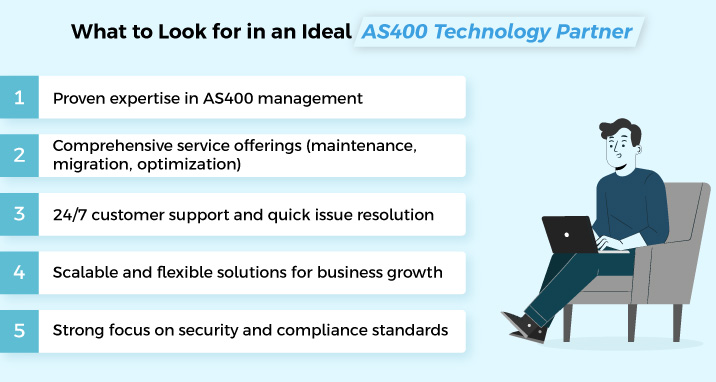
Offers Fixed Pricing Model
Every IT leader has been given a budget by their organization to achieve targeted goals while adhering to a predetermined IT strategy for the year. Choosing an IBM i software support service provider with ambiguous or hidden prices can cost you a fortune.
Look for partners who provide fixed-price plans that are tailored to your specific business requirements. You can choose a pricing strategy that allows you to pay just for what you need and how much you use it.
Offers 360-degree RPG Programming Expertise
This is something to consider while building a team for IBM i Software Support Service work.
Because iSeries software support relies primarily on RPG language, it is prudent to assess the RPG skills and quality of IT professionals before hiring and onboarding them.
Your search ends here at Integrative Systems!
Why Choose Integrative Systems as Your IBM i Technology Partner?
With extensive experience in IBM technologies, our team of experts can help you streamline your operations, enhance productivity, and drive business growth.
Here’s how we can assist –
Expert Consultation and Strategy
Our seasoned IBM i experts will work closely with you to understand your specific business needs and objectives. Leveraging their industry-wide experience, they’ll develop a tailored strategy to optimize your IBM i environment.
Whether you’re looking to streamline your operations, enhance security, or integrate new technologies, our consultants will provide the guidance you need.
Seamless Integration and Migration
We specialize in seamlessly integrating IBM i into your IT infrastructure. We also provide migration services to help you transition from outdated systems to the latest IBM i solutions. We aim to ensure minimal disruption to your operations during this transition while maximizing system performance and efficiency.
Robust Security Measures
We understand the critical importance of data security. Our experts will implement robust security measures to protect your IBM i environment from potential threats. From securing your data at rest and in transit to setting up firewalls and intrusion detection systems, we’ll ensure your data remains secure.
Ongoing Support and Maintenance
Our commitment to you doesn’t end once your IBM i environment is up and running. We provide ongoing support and maintenance to ensure your systems continue to operate smoothly. From troubleshooting system issues to providing regular software updates, our team is always on standby to assist.
Cost-Effective Solutions
We believe that top-notch IT services shouldn’t break the bank. We strive to provide cost-effective solutions without compromising on quality. By outsourcing your IBM i management to us, you’ll save on the costs of hiring, training, and retaining an in-house team.
We bring in over two decades of industry experience and expertise dealing with IBM i AS400 software solutions.
We have been involved in every level of the application design and development process for our IBM i AS400 clients.
Understanding functional requirements, software architecture, scoping technical requirements, and clarifying actual business goals are all part of the process. We also assist with the implementation and maintenance of the solution.
Drop us a line at [email protected] with your business goals and requirements, and our team of experts will get back to you within two business days.



